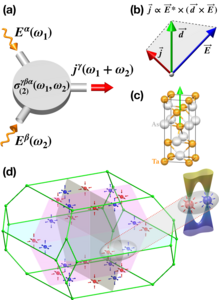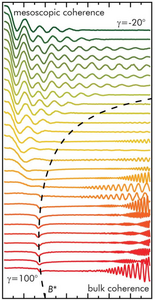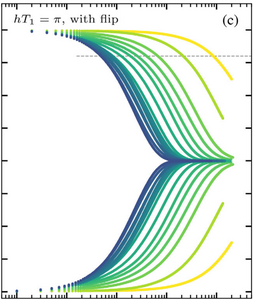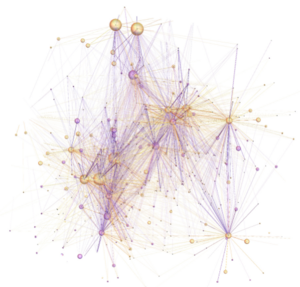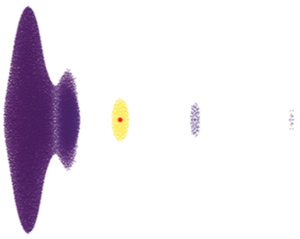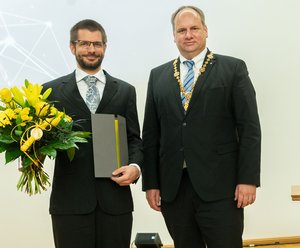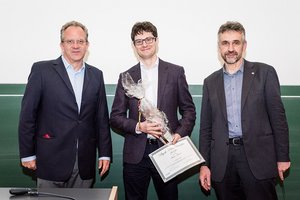
Highlights
Publication Highlights
Nonlinear Hall Acceleration and the Quantum Rectification Sum Rule
Electrons moving in a Bloch band are known to acquire an anomalous Hall velocity proportional to the Berry curvature of the band which is responsible for the intrinsic linear Hall effect in materials with broken time-reversal symmetry. Here, we demonstrate that there is also an anomalous correction to the electron acceleration which is proportional to the Berry curvature dipole and is responsible for the nonlinear Hall effect recently discovered in materials with broken inversion symmetry. This allows us to uncover a deeper meaning of the Berry curvature dipole as a nonlinear version of the Drude weight that serves as a measurable order parameter for broken inversion symmetry in metals. We also derive a quantum rectification sum rule in time reversal invariant materials by showing that the integral over frequency of the rectification conductivity depends solely on the Berry connection and not on the band energies. The intraband spectral weight of this sum rule is exhausted by the Berry curvature dipole Drude-like peak, and the interband weight is also entirely controlled by the Berry connection. This sum rule opens a door to search for alternative photovoltaic technologies based on the Berry geometry of bands. We also describe the rectification properties of Weyl semimetals which are a promising platform to investigate these effects.
O. Matsyshyn and I. Sodemann, Phys. Rev. Lett 123, 246602 (2019)
Read moreO. Matsyshyn and I. Sodemann, Phys. Rev. Lett 123, 246602 (2019)
Publication Highlights
h/e oscillations in interlayer transport of delafossites
Microstructures can be carefully designed to reveal the quantum phase of the wave-like nature of electrons in a metal. Here, we report phase-coherent oscillations of out-of-plane magnetoresistance in the layered delafossites PdCoO2 and PtCoO2. The oscillation period is equivalent to that determined by the magnetic flux quantum, h/e, threading an area defined by the atomic interlayer separation and the sample width, where h is Planck’s constant and e is the charge of an electron. The phase of the electron wave function appears robust over length scales exceeding 10 micrometers and persisting up to temperatures of T > 50 kelvin. We show that the experimental signal stems from a periodic field modulation of the out-of-plane hopping. These results demonstrate extraordinary single-particle quantum coherence lengths in delafossites.
C. Putzke et al., Science 368, 1234 (2020)
Read moreC. Putzke et al., Science 368, 1234 (2020)
Publication Highlights
Prethermalization without Temperature
While a clean, driven system generically absorbs energy until it reaches “infinite temperature,” it may do so very slowly exhibiting what is known as a prethermal regime. Here, we show that the emergence of an additional approximately conserved quantity in a periodically driven (Floquet) system can give rise to an analogous long-lived regime. This can allow for nontrivial dynamics, even from initial states that are at a high or infinite temperature with respect to an effective Hamiltonian governing the prethermal dynamics. We present concrete settings with such a prethermal regime, one with a period-doubled (time-crystalline) response. We also present a direct diagnostic to distinguish this prethermal phenomenon from its infinitely long-lived many-body localized cousin. We apply these insights to a model of the recent NMR experiments which, intriguingly, detected signatures of a Floquet time crystal in a clean three-dimensional material. We show that a mild but subtle variation of their driving protocol can increase the lifetime of the time-crystalline signal by orders of magnitude.
D. J. Luitz et al., Phys. Rev. X 10, 021046 (2020)
Read moreD. J. Luitz et al., Phys. Rev. X 10, 021046 (2020)
Publication Highlights
Extended Coherently Delocalized States in a Frozen Rydberg Gas
The long-range dipole-dipole interaction can create delocalized states due to the exchange of excitation between Rydberg atoms. We show that even in a random gas many of the single-exciton eigenstates are surprisingly delocalized, composed of roughly one quarter of the participating atoms. We identify two different types of eigenstates: one which stems from strongly-interacting clusters, resulting in localized states, and one which extends over large delocalized networks of atoms. These two types of states can be excited and distinguished by appropriately tuned microwave pulses, and their relative contributions can be modified by the Rydberg blockade and the choice of microwave parameters.
Abumwis et al., Phys. Rev. Lett. 124, 193401 (2020)
Read moreAbumwis et al., Phys. Rev. Lett. 124, 193401 (2020)
Institute's News
Next Step Fellowships at MPI-PKS
Our institute now offers Postdoc and PhD fellowships for scientists who were planning to leave Europe and take up their next position outside of Europe but currently cannot do so due to the covid19 pandemic. Applications are reviewed regularly, with the next deadline on 7. July 2020.
Read moreInstitute's News
MPI-PKS launches virtual workshop jointly with ICTP
In times of severe travel constraints or even lockdowns, MPI-PKS is determined to provide opportunities for scientists to meet, now remotely. As a pilot event, we are launching a two-day virtual workshop jointly with ICTP in Trieste, focusing on Real-time Dynamics in Strongly correlated Quantum Matter.
Read morePublication Highlights
Hierarchy of Relaxation Timescales in Local Random Liouvillians
To characterize the generic behavior of open quantum systems, we consider random, purely dissipative Liouvillians with a notion of locality. We find that the positivity of the map implies a sharp separation of the relaxation timescales according to the locality of observables. Specifically, we analyze a spin-1/2 system of size $\ell$ with up to $n$-body Lindblad operators, which are $n$ local in the complexity-theory sense. Without locality ($n=\ell$), the complex Liouvillian spectrum densely covers a “lemon”-shaped support. However, for local Liouvillians ($n<\ell$), we find that the spectrum is composed of several dense clusters with random matrix spacing statistics, each featuring a lemon-shaped support wherein all eigenvectors correspond to $n$-body decay modes. This implies a hierarchy of relaxation timescales of n-body observables, which we verify to be robust in the thermodynamic limit. Our findings for n locality generalize immediately to the case of spatial locality, introducing further splitting of timescales due to the additional structure.
Wang et al., Phys. Rev. Lett. 124, 100604 (2020)
Read moreWang et al., Phys. Rev. Lett. 124, 100604 (2020)
Awards and Honors
Dresden Excellence Award 2019
Stadt Dresden zeichnet zum dritten Mal herausragende Abschlussarbeiten mit dem Wissenschaftspreis aus.
Am Sonnabend, 29. Februar 2020, vergibt die Landeshauptstadt Dresden gemeinsam mit dem Netzwerk „Dresden – Stadt der Wissenschaften“ den mit 30 000 Euro dotierten DRESDEN EXCELLENCE AWARD. „Mit dem Wissenschaftspreis der Stadt Dresden zeichnen wir als Stadtverwaltung zum dritten Mal in Folge vier Absolventinnen und Absolventen Dresdner Hochschulen für ihre hervorragenden wissenschaftlichen Abschlussarbeiten aus. Diese Würdigung stärkt die Wahrnehmung Dresdens als exzellenten Wissenschaftsstandort“, sagt Oberbürgermeister Dirk Hilbert, der zugleich als Vorsitzender der Jury wirkte.
Ausgezeichnet werden in jedem Jahr vier eingereichte Arbeiten, die besondere Relevanz und Zukunftsorientierung für die Dresdner Stadtentwicklung und Stadtgesellschaft vorweisen.
Die mit 12 000 Euro dotierte Auszeichnung in der Kategorie Habilitation geht an Dr. habil. Sebastian Wüster für seine Habilitationsschrift „Quantentransport in ultrakalten Rydberg Aggregaten“. Die Forschung in der theoretischen Physik untersucht die Anwendung von kalten Rydberg Aggregaten auf in der Quantensimulation relevante Transportprozesse. Dr. Wüster publizierte im Rahmen seiner Habilitation 15 wissenschaftliche Arbeiten, darunter einen Review Artikel und sechs Physical Review Letters. Mit dieser Leistung wird Dr. Wüster als internationaler Experte ultrakalter Rydbergphysik wahrgenommen und ist zunächst auf eine Assistenzprofessur in Ankara/Türkei und schließlich als Assoziierter Professor an das Indian Institute for Science, Education and Research Bhopal/Indien berufen worden. Damit setzt Dr. Wüster nun mit seiner eigenen Forschungsgruppe international die Dresdner Forschung in der theoretischen Physik auf höchstem wissenschaftlichen Niveau fort.
Read moreAm Sonnabend, 29. Februar 2020, vergibt die Landeshauptstadt Dresden gemeinsam mit dem Netzwerk „Dresden – Stadt der Wissenschaften“ den mit 30 000 Euro dotierten DRESDEN EXCELLENCE AWARD. „Mit dem Wissenschaftspreis der Stadt Dresden zeichnen wir als Stadtverwaltung zum dritten Mal in Folge vier Absolventinnen und Absolventen Dresdner Hochschulen für ihre hervorragenden wissenschaftlichen Abschlussarbeiten aus. Diese Würdigung stärkt die Wahrnehmung Dresdens als exzellenten Wissenschaftsstandort“, sagt Oberbürgermeister Dirk Hilbert, der zugleich als Vorsitzender der Jury wirkte.
Ausgezeichnet werden in jedem Jahr vier eingereichte Arbeiten, die besondere Relevanz und Zukunftsorientierung für die Dresdner Stadtentwicklung und Stadtgesellschaft vorweisen.
Die mit 12 000 Euro dotierte Auszeichnung in der Kategorie Habilitation geht an Dr. habil. Sebastian Wüster für seine Habilitationsschrift „Quantentransport in ultrakalten Rydberg Aggregaten“. Die Forschung in der theoretischen Physik untersucht die Anwendung von kalten Rydberg Aggregaten auf in der Quantensimulation relevante Transportprozesse. Dr. Wüster publizierte im Rahmen seiner Habilitation 15 wissenschaftliche Arbeiten, darunter einen Review Artikel und sechs Physical Review Letters. Mit dieser Leistung wird Dr. Wüster als internationaler Experte ultrakalter Rydbergphysik wahrgenommen und ist zunächst auf eine Assistenzprofessur in Ankara/Türkei und schließlich als Assoziierter Professor an das Indian Institute for Science, Education and Research Bhopal/Indien berufen worden. Damit setzt Dr. Wüster nun mit seiner eigenen Forschungsgruppe international die Dresdner Forschung in der theoretischen Physik auf höchstem wissenschaftlichen Niveau fort.
Publication Highlights
"Census" in the zebrafish's brain
Dresden scientists explore newborn, regenerated neurons
The zebrafish is a master of regeneration: If brain cells are lost due to injury or disease, it can simply reproduce them - contrary to humans where this only happens in the fetal stage. However, the zebrafish is evolutionarily related to humans and, thus, possesses the same brain cell types as humans. Can a hidden regeneration potential also be activated in humans? Are therapies for stroke, craniocerebral trauma and presently incurable diseases such as Alzheimer's and Parkinson's possible?
Dresden scientists have now succeeded in determining the number and type of newly formed neurons in zebrafish; practically conducting a “census” in their brains. Following an injury, zebrafish form new neurons in high numbers and integrate them into the nervous system, which is the reason for their amazing brain regeneration ability. The study is a true collaboration project “made in Dresden”: Scientists from the Center for Regenerative Therapies TU Dresden (CRTD) combined their expertise in stem cell biology with complex bio-informatic analyses from the Max Planck Institute for the Physics of Complex Systems (MPI-PKS) and the Center for Systems Biology Dresden (CSBD) and with the latest sequencing methods from the DRESDEN-concept Genome Center.
For their study now published in Development, the team led by Christian Lange and Michael Brand from the CRTD used adult transgenic zebrafish in whose forebrain they were able to identify the newborn neurons. The forebrain of the zebrafish is the equivalent to the human cerebral cortex, the largest and functionally most important part of the brain. Together with the Steffen Rulands group at the MPI-PKS and the CSBD, the interdisciplinary research team investigated the newborn and mature neurons as well as brain stem cells using single cell sequencing. Thus, they discovered specific markers for newborn neurons and were able to comprehensively analyze which types of neurons are newly formed in the adult brain of the zebrafish. Together, researchers also investigated the data obtained from brain cells of mice and found that zebrafish and mice have the same cell types. This also makes these results highly relevant for humans.
"On the basis of this study, we will further investigate the regeneration processes that take place in zebrafish. In particular, we will study the formation of new neurons after traumatic brain damage and their integration," explains Michael Brand, CRTD Director and senior author of the study. "We hope to gain insights that are relevant for possible therapies helping people after injuries and strokes or suffering from neurodegenerative diseases. We already know that a certain regenerative ability is also present in humans and we are working on awakening this potential. The results of our study are also important for understanding the conditions under which transplanted neurons can network with the existing ones and thus could let humans re-gain their former mental performance.”
Original Publication: Christian Lange, Fabian Rost, Anja Machate, Susanne Reinhardt, Matthias Lesche, Anke Weber, Veronika Kuscha, Andreas Dahl, Steffen Rulands and Michael Brand: „Single cell sequencing of radial glia progeny reveals diversity of newborn neurons in the adult zebrafish brain”
Development 20 147, published 9 January 2020, doi: 10.1242/dev.185595
Read moreDresden scientists have now succeeded in determining the number and type of newly formed neurons in zebrafish; practically conducting a “census” in their brains. Following an injury, zebrafish form new neurons in high numbers and integrate them into the nervous system, which is the reason for their amazing brain regeneration ability. The study is a true collaboration project “made in Dresden”: Scientists from the Center for Regenerative Therapies TU Dresden (CRTD) combined their expertise in stem cell biology with complex bio-informatic analyses from the Max Planck Institute for the Physics of Complex Systems (MPI-PKS) and the Center for Systems Biology Dresden (CSBD) and with the latest sequencing methods from the DRESDEN-concept Genome Center.
For their study now published in Development, the team led by Christian Lange and Michael Brand from the CRTD used adult transgenic zebrafish in whose forebrain they were able to identify the newborn neurons. The forebrain of the zebrafish is the equivalent to the human cerebral cortex, the largest and functionally most important part of the brain. Together with the Steffen Rulands group at the MPI-PKS and the CSBD, the interdisciplinary research team investigated the newborn and mature neurons as well as brain stem cells using single cell sequencing. Thus, they discovered specific markers for newborn neurons and were able to comprehensively analyze which types of neurons are newly formed in the adult brain of the zebrafish. Together, researchers also investigated the data obtained from brain cells of mice and found that zebrafish and mice have the same cell types. This also makes these results highly relevant for humans.
"On the basis of this study, we will further investigate the regeneration processes that take place in zebrafish. In particular, we will study the formation of new neurons after traumatic brain damage and their integration," explains Michael Brand, CRTD Director and senior author of the study. "We hope to gain insights that are relevant for possible therapies helping people after injuries and strokes or suffering from neurodegenerative diseases. We already know that a certain regenerative ability is also present in humans and we are working on awakening this potential. The results of our study are also important for understanding the conditions under which transplanted neurons can network with the existing ones and thus could let humans re-gain their former mental performance.”
Original Publication: Christian Lange, Fabian Rost, Anja Machate, Susanne Reinhardt, Matthias Lesche, Anke Weber, Veronika Kuscha, Andreas Dahl, Steffen Rulands and Michael Brand: „Single cell sequencing of radial glia progeny reveals diversity of newborn neurons in the adult zebrafish brain”
Development 20 147, published 9 January 2020, doi: 10.1242/dev.185595
Awards and Honors
Physik-Preis Dresden
Am 14. Januar 2020 wird der Physik-Preis Dresden des Max-Planck-Instituts für Physik komplexer Systeme (MPI-PKS) und der TU Dresden an Dr. Adam Nahum von der Oxford University vergeben. Die Preisverleihung findet ab 16 Uhr im Rahmen eines Festkolloquiums im Recknagel-Bau der TU Dresden statt.
Adam Nahum hat in seiner noch jungen wissenschaftlichen Laufbahn bereits eine Reihe exzellenter und vielbeachteter Beiträge geleistet. Besonders kennzeichnend für ihn ist seine herausragende Fähigkeit, Konzepte aus verschiedenen Bereichen der theoretischen Physik zu einem universellen Verständnis des Verhaltens komplexer Systeme zu verbinden und so tiefe Einsichten zu erhalten.
„Die Originalität seiner Ansätze und die außergewöhnliche Vielfalt seiner Forschungsthemen, verkörpern in idealer Weise den Grundgedanken des Physik-Preises Dresden,“ begründet Prof. Walter Strunz, Vorsitzender des Preiskomitees, die Entscheidung für Adam Nahum. Verankert in dem Grundgedanken „Die Zukunft gehört denjenigen, die zusammen arbeiten“ ist es das Ziel des Preises, gerade solche herausragenden Forscherinnen und Forscher auszuzeichnen, an deren Arbeiten beide DRESDEN-concept-Partner MPI-PKS und TU Dresden besonders interessiert sind.
An Nahums Forschungsgebieten, darunter Quantenvielteilchenphysik, Nichtgleichgewicht oder Quantenchaos arbeiten verschiedene Gruppen der TU Dresden und des MPI-PKS. Viele der Dresdner Physiker freuen sich daher auf den einwöchigen Aufenthalt des Preisträgers, der weitere Fachvorträge und vor allem viel Raum für Diskussionen mit sich bringt.
Der Preisträger Adam Nahum
Adam Nahum hat in Oxford und Chicago Physik und Philosophie studiert und 2013 an der Universität Oxford über kritische Phänomene in Schleifen-Modellen promoviert. Nach einer Postdoc-Phase am Massachusetts Institute of Technology (MIT) ist er seit 2017 wieder an der Oxford University.
Read more
